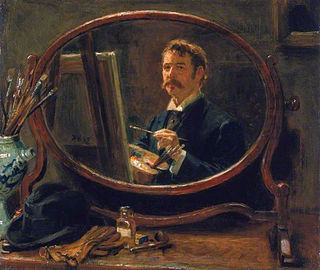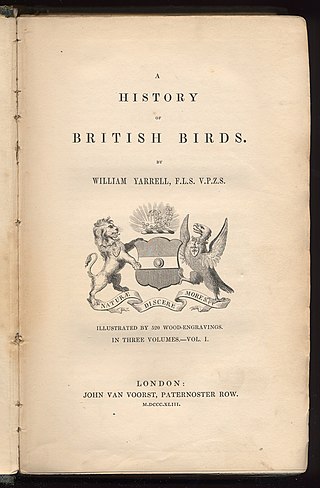
Engraving is the practice of incising a design onto a hard, usually flat surface by cutting grooves into it with a burin. The result may be a decorated object in itself, as when silver, gold, steel, or glass are engraved, or may provide an intaglio printing plate, of copper or another metal, for printing images on paper as prints or illustrations; these images are also called "engravings". Engraving is one of the oldest and most important techniques in printmaking.

Woodcut is a relief printing technique in printmaking. An artist carves an image into the surface of a block of wood—typically with gouges—leaving the printing parts level with the surface while removing the non-printing parts. Areas that the artist cuts away carry no ink, while characters or images at surface level carry the ink to produce the print. The block is cut along the wood grain. The surface is covered with ink by rolling over the surface with an ink-covered roller (brayer), leaving ink upon the flat surface but not in the non-printing areas.

Thomas Bewick was an English wood-engraver and natural history author. Early in his career he took on all kinds of work such as engraving cutlery, making the wood blocks for advertisements, and illustrating children's books. He gradually turned to illustrating, writing and publishing his own books, gaining an adult audience for the fine illustrations in A History of Quadrupeds.

Wood engraving is a printmaking technique, in which an artist works an image into a block of wood. Functionally a variety of woodcut, it uses relief printing, where the artist applies ink to the face of the block and prints using relatively low pressure. By contrast, ordinary engraving, like etching, uses a metal plate for the matrix, and is printed by the intaglio method, where the ink fills the valleys, the removed areas. As a result, the blocks for wood engravings deteriorate less quickly than the copper plates of engravings, and have a distinctive white-on-black character.

Ovingham is a civil parish and village in the Tyne Valley of south Northumberland, England. It lies on the River Tyne 10 miles (16 km) east of Hexham with neighbours Prudhoe, Ovington, Wylam and Stocksfield.
Mickley is a cluster of small settlements and former civil parish, now in the parish of Prudhoe, in the Tyne Valley, between Prudhoe and Stocksfield in the English county of Northumberland, England. It lies south of the River Tyne and is accessible via the A695. The electoral ward of Mickley comprises the hamlets of Mickley Square, West Mickley, High Mickley, plus Cherryburn and Eltringham Farm. The population is a little under one thousand. In 1951 the parish had a population of 1862.

Ralph Hedley was a realist painter, woodcarver and illustrator, best known for his paintings portraying scenes of everyday life in the North East of England.

William Harvey was a British wood-engraver and illustrator.

John Hancock was a British naturalist, ornithologist, taxidermist and landscape architect. Working during the golden age of taxidermy when mounted animals became a popular part of Victorian era interior design, Hancock is considered the father of modern taxidermy

The Shakespeare Birthplace Trust (SBT) is an independent registered educational charity based in Stratford-upon-Avon, Warwickshire, England, that came into existence in 1847 following the purchase of William Shakespeare's birthplace for preservation as a national memorial. It can also lay claim to be the oldest conservation society in Britain. Receiving no government funding or public subsidies, it is totally dependent upon the public for support, and relies on donations and the income generated from visitors.

Luke Clennell was a British wood-engraver and painter.
David John Chambers is an English bibliographer, printing historian, printer and book-collector. Throughout a career in insurance, latterly as a non-marine underwriter for AS Harrison Syndicate 56 at Lloyd's of London, and more recently in retirement, Chambers has studied books and ephemera relating to printing, typography, book-illustration, private presses, the book-arts, English art and literature, and has published books and articles on a wide range of related subjects. Since 1979 he has edited, or co-edited, The Private Library, the quarterly journal of the Private Libraries Association, a bibliophile society of which he has been Chairman since the 1970s, and a Council member from the late 1950s.

Charlton Nesbit was a British wood-engraver.
Allen Robert Branston (1778–1827) known more generally as Robert Branston, was a British wood-engraver.
Thomas, his wife Margaret, their eldest son Thomas (Junior) and second son, George Angus were members of a Tyneside family who ran a printing and publishing business between 1774 and 1825, very important at the time for the Chapbook business.
Jane Bewick (1787–1881) was the eldest daughter of Isabella and wood-engraver Thomas Bewick. She edited her father's biography and supervised his works. She and her sister Isabella Bewick agreed that the Bewick engravings, blocks and papers should be donated to institutions including the British Museum.

A History of British Birds is a natural history book by Thomas Bewick, published in two volumes. Volume 1, Land Birds, appeared in 1797. Volume 2, Water Birds, appeared in 1804. A supplement was published in 1821. The text in Land Birds was written by Ralph Beilby, while Bewick took over the text for the second volume. The book is admired mainly for the beauty and clarity of Bewick's wood-engravings, which are widely considered his finest work, and among the finest in that medium.

William Yarrell's A History of British Birds was first published as a whole in three volumes in 1843, having been serialised, three sheets every two months, over the previous six years. It is not a history of ornithology but a natural history, a handbook or field guide systematically describing every species of bird known to occur in Britain. A separate article of about six pages, containing an image, a description, and an account of worldwide distribution, together with reports of behaviour, is provided for each species.

John Thompson was a British wood-engraver. He is best known for his contribution to William Yarrell's 1843 History of British Birds. He was described as the most distinguished wood-engraver of his time.
Hilary Paynter, Hon. RBSA, RE, FRSA, SWE is a British wood engraver and printmaker.























